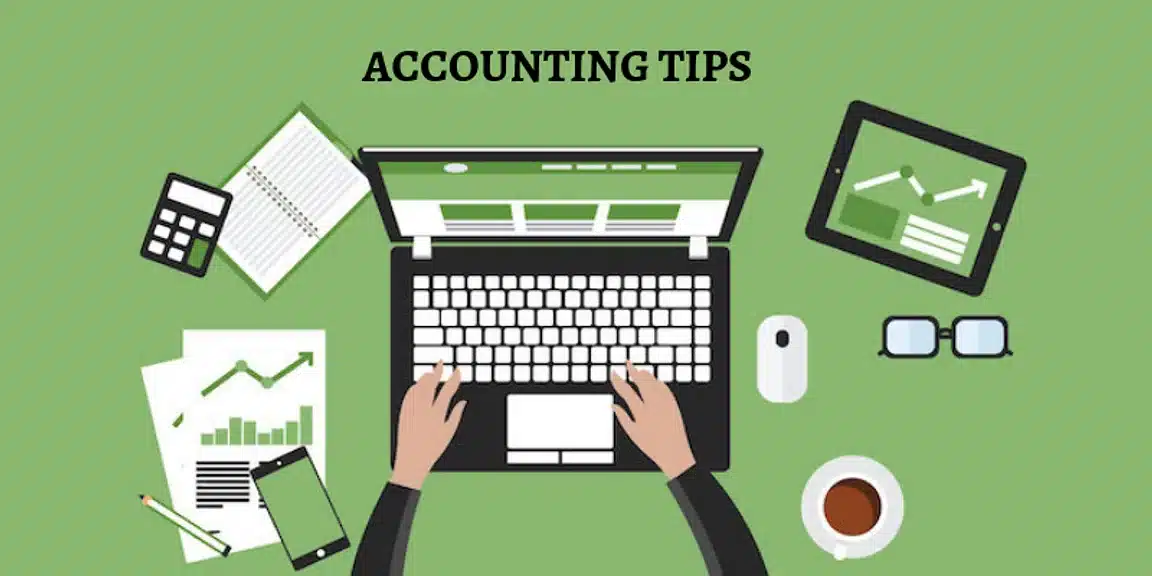702-660-7000
702-660-7000

Properly handling and tracking a business’s money and having someone focused on this task are essential for the success of both small businesses and startups.
About 20% of businesses do not survive beyond their first year. Moreover, only 30% of small businesses manage to stay operational ten years after their initial launch. To avoid the financial problems that often lead to business failures, it’s crucial to stick to sound accounting practices and consider hiring someone specifically responsible for managing finances. Following sound accounting practices can also contribute to the growth of small businesses.
Every small business should follow sound accounting practices to ensure good financial status. And if you aren’t making money, it’s better to know that sooner than later which good accounting practices will help you to recognize.
Here are some good practices to follow:
When starting a small business, open a dedicated business bank account. This can be done after obtaining an Employer Identification Number (EIN), while sole proprietors can use their social security numbers. Having a business bank account:
Businesses should consider opening a checking account, credit card, and a merchant services account to accept credit and debit card payments from customers.
Bookkeeping involves the organized tracking of all income and expenses, serving as a crucial aspect of financial management. It ensures that business owners have the necessary information to make informed financial decisions. If you don’t have bookkeeping expertise, it may be a smart move to hire a bookkeeper.
Accounting software automates bookkeeping tasks that are time-consuming and prone to errors when done manually. It simplifies the process of gathering information for creating financial statements. Small businesses are increasingly adopting cloud-based accounting software. While most businesses begin with basic accounting software, as they expand and become more complex, they might need to invest in an enterprise resource planning (ERP) system. Once implemented, an ERP system can incorporate modules for various business functions, all tied to a single database.
When crafting a business plan, one of the initial steps is to develop revenue projections and a list of expected expenses. Then, compare this budget to actual revenue and expenditures. The Federal Reserve Banks of Chicago and San Francisco found that more than 60% of financially healthy businesses create a budget and establish a separate bank account for payroll. Fewer than 5% of financially struggling businesses engage in these two crucial financial management practices.
Keeping track of your financial transactions is a crucial responsibility for small business owners. Accounting software can simplify this process and store financial records digitally. This makes it convenient to document the details of a transaction, including the amount, date, location, and business purpose, especially when you’re claiming expenses as tax deductions. The IRS typically requires you to retain these records for at least three years, but accountants often recommend keeping them for seven years. IRS Publication 583 provides a detailed list of the records that businesses need to maintain. Here are some of the records small businesses and startups should keep:
Gross Receipts: These represent your business’s income and include records like cash register tapes, deposit information (for both cash and credit sales), receipt books, invoices, and Forms 1099-MISC.
Expenses: These are the costs associated with running your business and include canceled checks or other payment proof, cash register receipts, account statements, credit card statements, and invoices.
Receipt scanners can simplify the process of digitizing receipts and invoices, making them easier to track. They automatically organize the contents into specific fields within accounting software. Accounting software may have its own mobile app or support third-party apps that allow employees or business owners to scan receipts using their smartphone cameras.
Fixed assets: These assets may include equipment, machinery, office furniture and career specific tools. Keeping track of the cost of your fixed assets allows you to calculate the annual depreciation on them and determine your gains or losses when selling them. Documentation for fixed assets may include purchase and sales invoices, real estate closing statements, canceled checks or other proof of payment, credit card statements, and invoices. Costs associated with acquiring limited-life intangible assets, such as digital software, trademarks, and website expenses can be amortized, while other asset categories like Current Assets (Bank accounts) or indefinite-life intangible assets are neither depreciated nor amortized.
Every small business and startup must choose a set of rules for reporting income and expenses consistently. This choice establishes the accounting method used for tax purposes. Generally, small businesses with annual gross receipts of $25 million or less for the three prior tax years can choose between accrual accounting and cash basis accounting. However, because Generally Accepted Accounting Principles (GAAP) require accrual accounting, many companies prefer this method.
Cash basis accounting can be simpler and more manageable for small businesses because it records revenue when payments are received and expenses when money leaves the company’s account. Accrual accounting records sales when products are shipped or services are delivered, which might be at the time of purchase in retail or several weeks or months after the sale in other industries. Accrual accounting involves double-entry bookkeeping and offers a more comprehensive view of a company’s financial health since it takes a long-term perspective.
Failing to keep your financial records current can lead to a lack of clarity regarding your company’s financial health, both for owners and employees. One way to ensure your records are always up to date is by automating the recording of receipts and invoices. You can also connect your bank accounts with your accounting software. While some businesses manually download credit card and bank statements and import them as CSV (Excel) files, certain accounting systems offer plugins that can fetch information from your bank account, automatically retrieve daily bank transactions and statement files, and help you reconcile the statements by defining matching rules within the system. Some accounting software even offers direct integration with banks, allowing business owners to manage all banking tasks within the accounting system without the need to log into their bank account portal.
To retain cash for a longer period, take advantage of credit terms offered by key suppliers. Pay bills following a schedule that maximizes your cash flow, and when possible, settle payments early to benefit from discounts provided by vendors. To ensure a consistent cash flow, take all necessary steps to encourage on-time payments from your customers. This may include offering discounts for early payments, conducting credit checks on potential customers before engaging in business, and revising credit terms if needed. Accounting software that automates the invoicing process, sending bills and follow-up reminders automatically, can also help prevent a buildup of outstanding invoices.
While public companies must adhere to regulations requiring the separation of duties, small businesses often have a single individual handling multiple accounting tasks. This arrangement can introduce the risk of accounting fraud. To mitigate this risk, owners can implement straightforward controls. One effective measure is to ensure that the person responsible for cutting checks is not the same person who signs the checks and reconciles the bank statements.
For most small businesses, labor costs represent the largest expense, with inventory being another substantial expense. To reduce labor expenses, many small businesses choose to outsource work to contractors who bill on an hourly basis. This approach can be cost-effective because contractors may not require 40 hours per week and do not need benefits.
Time-tracking software can help business leaders understand the cost of specific tasks, enabling better budgeting and expense control. To lower inventory costs, businesses can track metrics such as inventory carrying costs, inventory turnover ratio, and the amount lost to obsolete inventory, allowing them to manage these expenses more effectively.
By consistently monitoring expenses and revenue, a business can better identify the timing for making major investments and establish the necessary credit to cover associated costs.
 57-page slide deck 57-page slide deck | Many people are losing money with typical financial planning. Even people who were "set for life" are running out of money in retirement. Here's an easy guide with 3 things you can do to become wealthier. Download here> |
Business credit cards can play a role in building a credit history, increasing the likelihood of qualifying for financing, including lines of credit and loans, but in today’s day and age, the business owner will usually have to sign a personal guarantee to get a business credit card or a loan anyway, as few banks are willing to extend credit directly to a business without a personal guarantee. Business credit cards can offer additional benefits, such as business rewards or travel rewards.
Many business owners also use participating whole life insurance to build personal capital in an environment which is also accessible for business financing needs. The business owner can take a policy loan personally, lend it to the business, and then the interest on the policy loan can still be tax deductible similar to a bank loan. Loan repayments then rebuild the owner’s personal life insurance asset which grows tax deferred and can eventually be used toward another purpose including funding for retirement. In many states, personal life insurance is also treated favorably when it comes to asset protection.
The IRS typically requires that sole proprietors, partners, and S corporation shareholders make estimated tax payments if they anticipate owing $1,000 or more when filing their tax return. Specific employment tax records that must be maintained can be found in IRS resources on Recordkeeping for Employers and the Employer’s Tax Guide. The IRS provides worksheets in Form 1040-ES, Estimated Tax for Individuals, or Form 1120-W, Estimated Tax for Corporations, to assist in calculating estimated tax. Businesses should also consult the IRS tax calendar, which outlines due dates and necessary actions.
The National Small Business Association (NSBA) reports that one out of every three small businesses spends over 40 hours annually on federal taxes. It’s common for about two-thirds of small businesses to enlist the services of an external tax professional or accountant to handle their tax matters. Sole proprietors, in particular, can benefit from this practice, as the cost of hiring someone to prepare a business’s tax return is tax-deductible. SOURCE
Accurate inventory data is essential for generating financial statements. If your business maintains much inventory, it will be necessary to calculate the cost of goods sold (COGS) for the income statement and determine the value of inventory on hand for the balance sheet. Physical inventory can be tracked through manual counts conducted regularly or through the use of an inventory management system that can automatically adjust numbers as sales occur, provided it is integrated with the point-of-sale system and accounting software. Implementing inventory management software not only simplifies the tracking process but also ensures the information is more precise.
These essential financial statements are generated based on the recording of expenses and income. Income statements provide insights into a business’s profitability, while a balance sheet offers a snapshot of its financial status at a specific moment, presenting assets, liabilities, and shareholders’ equities. On the other hand, the cash flow statement or Profit/Loss report reveals the movement of money into and out of the business during a particular period, highlighting the remaining cash on hand. When combined with the balance sheet, the cash flow statement helps determine if a company has sufficient funds to meet its current obligations. These three reports are important when seeking financing or funding from banks or investors.
Financial projections can assist businesses in estimating future income and expenses, helping them anticipate the need for financing or potential capital expenditures. These forecasts enable business leaders to gauge cash flow and make informed decisions about pricing and production plans.
Financial projections become particularly valuable when a business seeks loans, funding, or becomes a target for acquisition, providing crucial financial insights to external stakeholders. Companies can also use these forecasts to develop pro-forma financial statements, which include projected income statements, balance sheets, and cash flow statements. Projections are based on financial modeling techniques and answer questions that may arise from lenders, investors, or other business stakeholders. At its core, projections address questions like: if we provide you with this capital, how will you utilize it, and how do you plan to repay it?
Establishing robust accounting processes from the outset is a proactive step that enhances the chances of success for small businesses and startups.
While bookkeeping may not be the primary passion of most small business owners, regular attention to vital financial metrics is helpful to identify growth opportunities and ensure a company remains profitable.
If you’re looking to build financial stability for your company, McFie Insurance is here to help. We have helped hundreds of small businesses and individuals improve their financial strategies.
We help business owners to build a strong personal reserve through cash value life insurance for financing major business purchases and managing cash flow in a way that also allows for long-term tax savings without cashing out investments or taking penalties on tax qualified plans for business funding.
Contact McFie Insurance today at 702-660-7000.
 by Jordan McFie
by Jordan McFie
Time is the one thing we are all limited by in this life. When writing content, I make sure it is accurate, to the point, and easy to read. Accurate information, that is easy to digest, saves the reader time and allows them to make important financial decisions quickly. (Yes this is an old picture - need to get an updated one.)